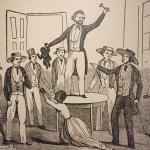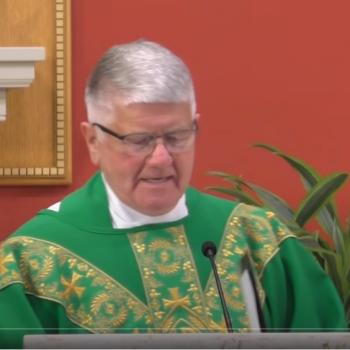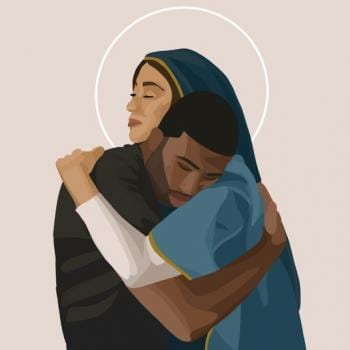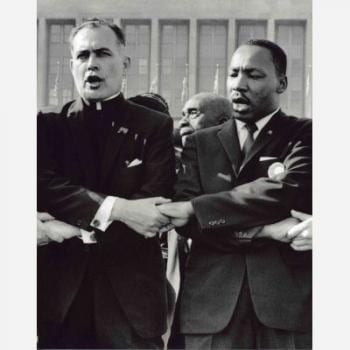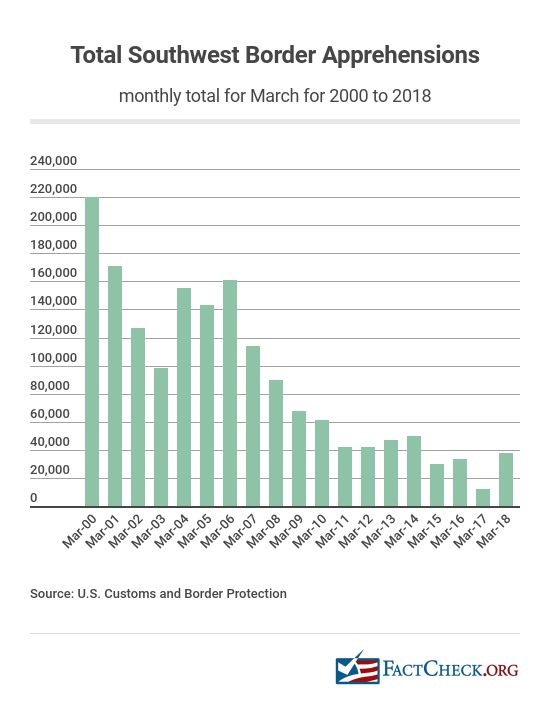 Okay, let’s be clear about one thing: There is no immigration crisis on the southern border of the United States. Illegal border crossings have been steadily declining since they reached their zenith in 2000. In fact, the “self-deportation” that Mitt Romney campaigned on in 2012 has been happening. The total number of undocumented people in the US peaked in 2007 at 12 million. The federal government’s estimate for 2016 was 10.9 million. The number for 2017 will likely be lower still because border crossings were a mere trickle last year. (See chart at left).
Okay, let’s be clear about one thing: There is no immigration crisis on the southern border of the United States. Illegal border crossings have been steadily declining since they reached their zenith in 2000. In fact, the “self-deportation” that Mitt Romney campaigned on in 2012 has been happening. The total number of undocumented people in the US peaked in 2007 at 12 million. The federal government’s estimate for 2016 was 10.9 million. The number for 2017 will likely be lower still because border crossings were a mere trickle last year. (See chart at left).
The supposed criminality of undocumented immigrants has also been exposed as a lie. Study after study has shown that immigrants overall, and undocumented immigrants specifically, account for far fewer arrests and incarcerations than native-born Americans. What about MS-13? Last year, MS-13 members accounted for .00075% of all illegal border crossers or just over 200 gang members out of 300,000 migrants. Most MS-13 members are US citizens, and like the Italian, Russian, Irish, and Asian mobs before them, the gang mostly preys on members of their own community. And according to the Justice Department, MS-13 is not growing. It’s total estimated membership – 10,000– is the same as it was a decade ago.
Last, undocumented immigrants do not drain state and federal treasuries. A study conducted by the Department of Health and Human Services last year showed that the net fiscal impact of undocumented workers was PLUS $63 Billion. That report was of course rejected by the White House, which ordered HHS to come up with new, alternative facts. It has not yet done so. Many, even most undocumented workers pay the same payroll taxes that Americans do, even for Social Security and Medicare, two programs they will never benefit from. And, of course, they pay sales tax on everything from food to gasoline. Just like you and me.
There is no immigration crisis on the southern border. That’s a lie. There is, however, a crisis in the Catholic Church, and it springs from Donald Trump’s success at manipulating the fears and racial resentments of white people, including Catholics. This crisis manifests itself most clearly in suburban white parishes, which share remarkable demographic traits with both the GOP and Fox News Channel in terms of average age, racial/ethnic identity, income, and other markers. So many parishioners and priests are gleeful at the prospect of punishing those who cross the border to escape violence and poverty; you know, those “invaders” and “terrorists” with names like Jesús, Maria, and José. They say that they are “pro-life” but cheer every attempt to kick the legs out from under a social safety net that does more to prevent abortion than all their rosaries and marches combined. They claim to be followers of Jesus Christ, the Prince of Peace, but there is no American war they don’t celebrate, no wartime cruelty – including torture – they don’t justify or minimize. They pride themselves on their superior morality, yet celebrate a president who is a pathological liar, an adulterer and sexual predator, a failed peddler of vice, a thief and grifter, a man who never attends church, says he doesn’t need forgiveness, and couldn’t quote even one verse of Scripture when pressed.
How did we get here? Over the last forty years Catholics have been indoctrinated – implicitly by the bishops, explicitly by many Catholic apostolates – that the Republican Party is the natural political home of American Catholics on account of abortion and gay marriage. Many of us have long lamented that in cozying up to the GOP in this way, the bishops were essentially authenticating the entirety of the Republican agenda, including those elements that deliberately target the poor, the sick, the elderly, children, refugees, and immigrants. That has always been vigorously denied, but now we’re seeing that in practical terms many Catholics are unable to distinguish Catholic teaching from the Trump agenda. Nor does it seem that they have any interest in doing so.
Studies will be forthcoming, no doubt, but for now all the evidence is experiential, personal, not scientific. I had my own experience last week. I was the altar server for the morning Mass. Our guest celebrant gave a homily in the closing moments of which he turned his attention to the southern border, specifically the issue of separating families. “I find it repugnant,” he said, “and we all should. Who are we? What are we becoming?” No sooner had we entered the sacristy following Mass than a woman, the head of the parish “Respect Life” committee was in there, defending the Trump Administration, justifying the separation of families, and minimizing the effects of that separation. And soon she was joined in this by a retired priest who had concelebrated Mass. When I pointed out that the bishops of the United States and Pope Francis had just pronounced the Trump Administration’s family separation policy to be “immoral,” I was answered with a snort.
This wasn’t my first such encounter. Following the election, another local Catholic sent me hate mail announcing that Donald Trump was God’s anointed servant and that I, as someone didn’t vote for Trump, was a pro-abort most likely going to Hell. (Full disclosure: In 2016, for the second presidential election in a row, I wrote in the name of Wendell Berry.) Then there are the things I’ve heard said at formal and informal parish gatherings: poor single mothers should be sterilized, we should just nuke the Middle East and be done with it, “the blacks” just want handouts, round ’em up and deport ’em, and so on.
We see similar things online, especially on social media. Friends and relatives who consign papal pronouncements on moral issues like immigration to the category of “opinion” (pace Lumen Gentium #25, I guess), who depict the US Conference of Catholic Bishops as a cabal of liberal schemers, who immediately brand those opposed to Trump on this matter or that as “pro-abortion,” and who eagerly offer the opinions of right-wing web sites as some kind of counter-parry against Scripture or the Catechism. What all this amounts to is essentially the elevation of political ideology over the Church. When, as so often is the case, it is focused on the supposed wisdom and divine destiny of Donald Trump, it is idolatry. And when it clashes on a fundamental level with the demands of Catholic moral and social teaching, it is heresy. And it is nothing new. Every generation wrestles with this. From the legalization of Christianity by Constantine, this has been our constant battle: keeping the wolves of the dominant culture from devouring Christ’s faithful people.
Alas, the fact is that the Church has mostly failed in this. That’s why Catholics have been in the vanguard of nearly every atrocity throughout Western history, from the Crusades and the Inquisition to Colonialism and the Holocaust. No doubt there are today hundreds or thousands of Catholics working near the border, separating young children from their parents, creating damage that psychologists routinely describe as “traumatic.” And as we know, there are millions more Catholics back home cheering them on. As Yeats observed, “the best lack all conviction, while the worst are full of passionate intensity.” And who are “the worst?” Why, they are the best gone wrong, for that old Latin phrase – “corruptio optimi pessima” – is still true: the corruption of the best is the worst.
What to do? Here’s my formula:
- First, PRAY for the Church. Not the United States, but the Church. She is our Mother and our first loyalty belongs to her. Pray that her wayward children will recover their senses and again attend to her voice. Pray for priests and bishops, that they will at long last have the courage to take a stand and, if necessary, model resistance.
- Second, ACT. Find the marginalized or vulnerable in your community and serve them. The Corporal and Spiritual Works of Mercy are the only antidote to indifference and hatred. Serve at a cost, serve without expecting return, serve without judgment, serve each person as if they were Jesus (because they are). Here’s a place to start. As Dorothy said, “As we come to know the seriousness of the situation, the war, the racism, the poverty in our world, we come to realize that things will not be changed simply by words or demonstrations. Rather, it’s a question of living one’s life in a drastically different way.”
- Third, LEARN. If you don’t know what Catholic Social Teaching is, you should. In fact, you must. Here’s a place to start. Here’s a place to learn more. And here’s a place to learn even more. Peter Maurin believed that the social doctrine of the Church was dynamite. He was right. Blow it!
- Fourth, IDENTIFY. If Matthew 25 teaches us anything it is that Jesus identifies with the victims of every society. We must share in that identity. We must take the point of view of those on the edges and at the bottom because that’s not just whereJesus is, but that’s whoJesus is.
- Fifth, we must RESIST. When evil is done – whether it is abortion, war, or family separation – that evil must be resisted. Don’t sweep issues under the rug. Challenge family and friends, even at a risk. More importantly, go public. Protest, organize, and vote. As your station in life permits, do even more, including providing active support for those targeted for injustice or engaging in civil disobedience. As Dorothy wrote, “Over and over again, people had to disobey lawful authority to follow the voice of their conscience. This obedience to God and disobedience to the State has, over and over again, happened throughout history. It is time again to cry out against our ‘leaders,’ to question (since it is not for us to say that they are evil) whether or not they are sane.
- Last, LOVE. This is the tough one, I’ll admit. I find it VERY difficult to love Donald J. Trump and anyone who idolizes or follows him, especially when they are so hateful. But love we must. We don’t have to like them. We don’t have to be in their presence, but we must love. As Dorothy said, “The final word is love.”

